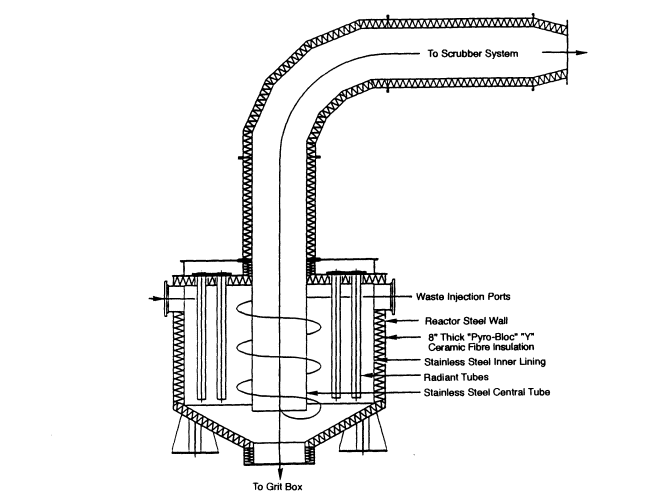Gas-Phase Chemical Reduction Technology
Process Description
from the National Academies Press
The gas-phase chemical reduction process reviewed by the AltTech Panel was submitted to the Army by ECO LOGIC, Inc., of Rockwood, Ontario. ECO LOGIC is the developer and TPC (Technology Proponent Company) for this technology and will be referred to as the TPC. The acronym GPCR will be used in the remainder of this report to refer to the particular process design submitted by this TPC for a gas-phase chemical reduction technology to destroy chemical agents. The process uses hydrogen and steam at elevated temperatures (up to 850°C) and nominally atmospheric pressure to transform organic wastes into simpler substances that are either less toxic or convertible to less toxic materials; these substances are also easier and safer to reuse or to release to the environment. The overall process requires a high temperature reaction vessel, where the chemical reduction occurs, followed by a gas scrubbing train to remove inorganic by-products. The process also includes provisions for removing other by-products and regenerating hydrogen gas through steam reforming.

Figure 1 is a schematic illustration of the process.
Chlorinated hydrocarbons, such as polychlorinated biphenyls (PCBs), are chemically broken down and reduced to methane (CH 4 )and HCl with CO and CO 2 as by-products. Nonchlorinated aromatic hydrocarbons such as toluene are reduced primarily to methane, with minor amounts of other light hydrocarbons. Carbon and presumably some heavier hydrocarbons are also produced.
The flow through stainless steel reactor has nozzles to accelerate the vaporization or dispersion of liquid wastes, which are injected directly into the reactor mix of hot gases consisting of H 2 , H 2 O, CO, and CO 2 . Within the reactor, radiant-tube heaters heat the mixture to 850°C. The residence time in the reactor is 2 to 6 seconds, although the TPC has stated that reactions occur in less than one second.
The gases exiting the reactor are scrubbed to remove by-products. Water is used as a quench to decrease the gas temperature and absorb water-soluble products, including HCl. These and other acidic products are further scrubbed by caustic scrubbers. A heavy-oil scrubber can be used in the scrubber train to remove some hydrocarbons. A standard monoethanolamine (MEA) scrubbing system removes most of the H 2 S (produced from sulfur-containing feeds) and CO 2 from the gas train. The separated H 2 S requires further treatment to convert it to elemental sulfur and water.
The TPC has also developed and employed a sequencing batch vaporizer (SBV), which is a high- temperature chamber (up to about 550°C) in which hot gases from the recirculating process stream, including H 2 , H 2 O, CO, and possibly CH 4 , desorb organic contaminants reactively and thermally from drums and bulk inorganic solids. The SBV consists of two autoclave-like chambers that are operated independently in batch mode. The chambers can be fairly largeŚlarge enough to hold a ton container. A high temperature thermal reduction mill (primarily a bath of molten tin) can also be used to separate contaminants from soil or solids; the tin is a heat transfer medium to drive off volatile material, leaving inert solids behind. The gases from the thermal reduction mill and SBV are swept into the reactor for treatment. GPCR incorporates equipment for catalytically reforming most of the methane from the reactor to H 2 , CO, and CO 2 ; the reformed gas is recirculated to the reactor to provide part of the necessary hydrogen.
The TPC has also developed mechanisms for holding gaseous process residuals for analysis prior to release or storage in containers. The overall process is monitored at a number of points using several methods: on line gas chromatography, chemical ionization mass spectrometry, a NOVA ® oxygen analyzer, and a NOVA ® gas analyzer to monitor H 2 , CO, CO 2 , and CH 4 .
The reactor ( Figure 2 ) is constructed of stainless steel with a ceramic lining. The feed stream and hot reactant gases are injected through several ports mounted on the reactor. Special nozzles disperse liquid wastes into the hot gas. The gas mixture is heated further by 18 vertical radiant-tube heaters, which are isolated from the reaction mixture by an atmosphere of CO 2 .

Figure 2
Original artricle at
https://nap.nationalacademies.org/read/5274/chapter/8#115
Compiled by Rami E. Kremesti M.Sc.